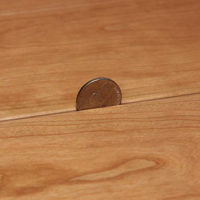
One of the reasons we love hardwood floors is that they bring the beauty and warmth of nature into our homes. As a part of nature, wood has a symbiotic relationship with its surrounding environment and reacts accordingly to the changes around it. The naturally drier air of winter, combined with our need for the comfort of artificial heat indoors, tends to remove a great deal of humidity from our homes. Wood stoves, fireplaces, and electric heat can exacerbate already low moisture levels even more.

Humidity Control is Key
The EPA advises that a relative humidity of 40-50 percent is optimal for human beings to be comfortable and healthy. Not surprisingly, wood also has a preferred comfort zone, which thankfully, closely mirrors ours. NWFA recommends humidity levels of 30-50 percent to maximize the appearance and lifespan of your floors. There are many economical hygrometers available for homeowners to monitor the humidity inside.
The first step to controlling your indoor environment is keeping the outside air……well, outside. Weatherproofing your home will not only make it more efficient to heat, but will reduce your floor’s exposure to the dry arctic air. Look for and address air leaks around windows and poorly sealed doors. Outlet and junction boxes on exterior walls are also often overlooked culprits for air leaks. The more that cold air finds its way into the house, the more you are required to heat the inside, which generally sucks more moisture out of that air.
Another easy solution is to introduce more moisture back into the environment. Humidifiers typically come either as a stand-alone unit that can be placed anywhere in the home or as a component of the home’s HVAC system. In either case, the key is to take it slow and introduce moisture gradually into the air. During winter months, 30-40 percent is a good target level to maximize comfort for you and your hardwood floors, while preventing condensation or risk of mold.
Relax
Environmental effects on wood can never truly be eliminated, but that is also what gives wood the character and beauty that we enjoy. Ultimately, homeowners must simply accept these seasonal changes as part of owning a hardwood floor, and enjoy the seasons as they manifest in the wood. Always keep in mind that keeping the humidity and temperature level at the recommended level is not only essential for keeping your hardwood floor looking great, but also provides you with an overall healthy home environment.



